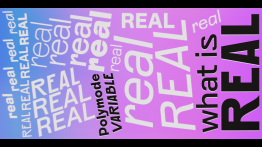What is Realness? Freeing type from a fixed viewpoint
Monday, June 10, 2024, 6:03 - 8:30pm

Can a single typeface express diverse viewpoints through its own functionality? Partners from two design studios, Polymode and XYZ Type, discuss their collaboration to bring notions of expansive personal identity into typographic form as part of the free Herb Lubalin Lecture Series. The unexpected road to their typeface Polymode Sans began by viewing a historical type revival through a queer lens, and led them to harness variable font technology as a form of cultural code-switching. Working on an abstract theoretical foundation, they created an entirely pragmatic tool: a typeface with both the versatile utility of a sans serif and the vigor of a decorative display face. This talk will follow their process through from initial idea to chameleonic applications, posing questions about collaboration, dialogue with history, and how designers express personal identity.
Ben Kiel is a typeface designer, an educator, and a partner in XYZ Type. He worked for several years at House Industries, with a specialty in solving complex problems at the overlap of design and technology. He received his M.A. in Typeface Design from the University of Reading and currently teaches at Washington University in Saint Louis and Type@Cooper.
Jesse Ragan designs a broad range of typefaces for XYZ Type, which he launched with Ben Kiel in 2017. Beyond making fonts from scratch, Ragan also specializes in customizing lettering for logotypes and helping clients understand how letterforms tick. He studied graphic design at Rhode Island School of Design. After interning at Font Bureau, he began his career at Hoefler & Frere-Jones before going out on his own for a decade. He cofounded Type@Cooper, has served on AIGA NY’s board of directors, and has taught at Cooper Union and Pratt Institute.
Silas Munro is a designer, artist, writer, and curator. He is the founder of the LGBTQ+ and minority-owned graphic design studio Polymode based in Los Angeles and Raleigh that works with clients across cultural spheres. Commissions and collaborations include The New York Times Magazine, Nike, the Brooklyn Museum, and Storefront for Art and Architecture among others. Munro is the curator and author of Strikethrough: Typographic Messages of Protest which opened at Letterform Archive in 2022–2023. He was a contributor to W. E. B. Du Bois’s Data Portraits: Visualizing Black America and co-authored the first BIPOC-centered design history course, Black Design in America: African Americans and the African Diaspora in Graphic Design 19–21st Century. As an artist his work was recently exhibited in the Raizes Gallery at Lesley University College of Art and Design, the 2023 LA Design Festival, and is included in the collections of Tufts University, Lesley University, and the Sally and Don Lucas Artist Residency Program in Montalvo. Munro is Founding Faculty, Chair Emeritus for the M.F.A. Program in Graphic Design at Vermont College of Fine Arts.
Brian Johnson, a member of the Monacan Indian Nation, is an award-winning designer, writer, and curator. He is a partner of Polymode where he focuses on amplifying marginalized and forgotten voices through poetic research, learning experiences, and impactful design. He has guest lectured and hosted workshops at the School of Visual Arts; the Walker Art Center; AIGA’s National Design Conference; his alma mater, the Rhode Island School of Design; and is one of the founders of the online learning platform BIPOC Design History. As a curator, he is the author of Posters That Sing, an exhibition scheduled to open September of 2026, at Poster House museum in New York. Deeply invested in the production of good design without the expense of sacrificing our humanity or environment, he extends these values to his recent clients such as The New York Times Magazine, Nike, the Brooklyn Museum, and Storefront for Art and Architecture. Johnson is the recipient of the 2023-24 Emily Hall Tremaine Journalism Fellowship for Curators where he is focusing on Indigenous-made works to combat erasure and decolonize design. The three-part article series, “Designing a History of Indigenous Graphic Artists”, “How can Posters Sing?”, and “Can We Find Our Way to Indigenous Joy?”, appear on Hyperallergic.
Located in the Frederick P. Rose Auditorium, at 41 Cooper Square (on Third Avenue between 6th and 7th Streets)




